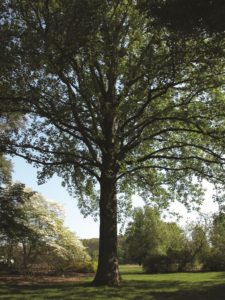By Andrew Berry

Isaac Bernheim emigrated to the United States in 1867 at the same time that John Muir was beginning his thousand mile walk to the Gulf of Mexico. As Muir walked through the area that would later become Bernheim Forest, he remarked on the oaks that he encountered, “I have seen oaks of many species in many kinds of exposure and soil, but those of Kentucky excel in grandeur all I had ever before beheld. They are broad and dense and bright green. In the leafy bowers and caves of their long branches dwell magnificent avenues of shade, and every tree seems to be blessed with a double portion of strong exulting life.”
Oaks are a group of keystone species that provides for a number of species, including humans. Found from the lowland swamps to the ridgetops, oaks produce acorns that provide food for a multitude of animals. Old trees form cavities that offer den sites for forest dwellers, and the shady canopies create favorable conditions for the herbaceous plants on the forest floor. The prosperity of the Louisville region can be largely attributed to the oak forests that were so abundant during settlement. Oak fueled the iron furnaces, provided structural materials for railroad ties, building construction, and the barrels for aging our world-famous bourbon.
Now under threat from a variety ailments commonly termed as oak decline, forest managers are focused on promoting oak regeneration. Bernheim protects over 10,000 acres of oak forest within our nearly 14,500 acre natural areas. We are committed to providing long term care for the oaks through our stewardship and research efforts. This year we are partnering with researchers to study oak regeneration and long term survivability under a variety of forest conditions.
Want more Vanishing Acts? Click here to view the archive.
Vanishing Acts: Trees Under Threat was developed and produced by The Morton Arboretum in association with the Global Trees Campaign, a partnership between Fauna and Flora International and Botanic Gardens Conservation International.
Funding for this exhibit comes from The Morton Arboretum and the U.S. Institute for Museum and Library Services, Museums for America Grant Program.
Support locally comes from LG&E and KU. Additional support provided by Shepherdsville/Bullitt County Tourism.


